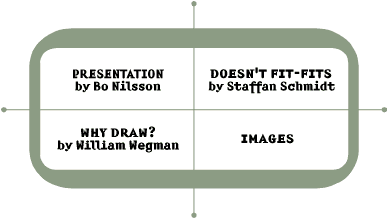
Wag the dog
Reflections on the Art of William Wegman
Introductions often serve as a kind of justification to explain why we have chosen to make an exhibition on a specific artist or why we have chosen a certain format for the exhibition. To Scandinavian art audiences, William Wegman is an evident and established name, but the image of him in the public mind may best be described as one-dimensional. Most associate him with his pictures of dogs, but for a deeper and more comprehensive understanding of his art a large variety of other kinds of works must be included. His oeuvre spans a wide artistic register, from paintings, drawings, and photography, to performance, video, and film. Many different media � all naturally represented in the Rooseum exhibition. I am extremely proud to be able to introduce his complex artistry, in a broad presentation, to the Swedish audience.
A film currently playing in American movie houses is called Wag the Dog. In it Robert de Niro plays a presidential consulant and Dustin Hoffman a Hollywood director whom together have been given the task of saving the US President from a threatening scandal. They characterize their task by comparing it to the difficulty in making the tail wag the dog, rather than the other way around. Something similer to an impossible task.
Not surprisingly, the film made me think of Wegman. His dog Man Ray made his artistic debut in his very earliest works involving video and photography. Story has it that the dog would not leave Wegman alone, and that the artist therefore decided to involve him in the creative process. In these early videos, the relationship between the dog and his master becomes a natural point of departure for an exploration in a process of complex interaction. But Wegman does not rest content with exploring only this connection. His later Polaroids of dogs stretched the limits further, as he gradually came to realize that the dogs, by themselves, were able to be the artistic focal point. In the large-scale, staged Polaroids to which he turned in 1979, the dogs are made to represent a number of biological roles: human beings, animals - but also imaginary figures which make me think of the expression wag the dog.
Of course we may laugh a bit embarrassed at their awkward attempt to play humans and we may sympathize with their psychology which sometimes seems to suggest that they actually believe that they are human. But they are always treated with respect. Wegman possesses special insight into the canine minds, in which play and work form a natural part of trust. Actually they have a lot to teach us about how we humans behave and how we relate to each other. He is really able to make them do whatever he wants - to make the tail wag the dog.
I therefore really looked forward to meeting the dogs. They turned out to be mostly inactive and bored around the studio. A walk around the neighborhood made them perk up, however. They suddenly sprang to life, following everything in the big city around them with curiosity, possessed of the gracefulness and tempo of a true New Yorker. It was obvious that they enjoyed star status among the crowds. They trotted along the street without missing a beat, aware of people�s eyes. They knew that they where recognized, like film stars or models. You kept expecting someone to ask them for a paw print. They are true celebrities, and nature feels very far away.
The dog pictures are clearly the documentation of an actual model and of the role that the model portrays. We must not get hung up on the fact that these roles are played by dogs, however. To do so is to reduce Wegman�s contribution to art to something peripheral. Wegman�s dog pictures undergo several stages, in which he explores a number of contemporary artistic issues. In this respect, he not only displays a contemporary aesthetic sensitivity but also skills that reveal a solid familiarity with history.
Wegman pays scant attention to modernism�s strictly defined rules pertaining to different media. On the contrary, he works with them in a parallel fashion. To him, modernist theory also includes photography - which has never been regarded as quite acceptable. But more than that: he refuses to strip down its inherent characteristics according to the precepts of modernism, but in opposition to the modernist insistence on refining a medium to bring out its characteristics, Wegman uses many different media.
Wegman�s art historical significance may be traced back to his video recordings from the early seventies on, and his experimentation with short black and white videos featuring himself. This is also when we first encounter his dogs. The trademark of these un-edited videoes is an absurd humor which questions the seriousness of contemporary art and also the aesthetic precision so characteristic of many of the videos at the time. In this respect, Wegman�s technically inferior videos resemble a kind of slacker-videos, common in the nineties, although usually lacking the economic effectiveness of Wegman�s one-liners.
The central axis of Wegman�s art is photography. The exhibition opens with photographs from the early seventies. They have little in common with the obvious role of modern photography as a depiction of reality. Wegman also problematizes the relationship of the photograph to reality by refusing to view the camera solely as an instrument for reproduction. He further complicates the documentary nature of the photograph by manipulating it by means of drawing or painting. He does the same to the photographs of others. This manipulation is sometimes very discreet, giving the work a vague suggestion that something is wrong - even though it is not always easy to discover exactly what. In other cases, he tackles the picture with great forcefulness. He poses questions. He never takes what we see for granted, but questions it, bringing our seeing into focus.
Alongside photography, Wegman has, since 1973, devoted himself to drawing - possibly as a counterweight to the mechanical dimension of the photographic image. There is a spontanous quality about his drawings. They seem to have grown out of the whim of the moment, like a fleeting vision. This is further underscored by the simplicity and apparant lack of complexity of his images, seemingly devoid of all calculation. In Wegman�s drawings no distinction is made between flops and masterpieces. They seem like some distraction, to be the result of a momentary whim, a fleeting reflection of the complex structure of impressions occasionally produced by the brain, in which banality is intermingled with genius.
Painting is, paradoxically, the most recent genre in Wegman�s world. Not until the eighties does he return to the medium in which he was actually trained. It may be the heavy cultural overlay of painting that accounts for the fact that he does not always feel at home with it. It is obvious that the anti-dogmatic tendencies in painting during the eighties, with its return to motif and story, had a liberating effect on Wegman. His rather large canvases contain grandiose perspectives, combined or constructed as some kind of panoramic landscape that often seems to parody abstract expressionist art and its gestural subjectivity. But Wegman appears to distrust the subjective urge for expression. Instead, he fills the large colored background with complex imagery in the form of maps of some kind with a recognizable reality and from a nebulous dream world. Their interconnection is not logically obvious within the larger context of the painting, but shows up more as the expression of an expanded feeling where relationships and entities form a kind of metaphysical dimension. In his respect, Wegman ties in with the romantic notion of abstract expressionist art that painting need not bear a strictly mimetic relationship to surrounding reality but may serve as metaphysical territory with an ability to transcend space and time, and to vaste excursions in history, but also into the future. Wegman�s paintings instill a feeling related to the futuristic dreams of a boy�s room.
Instead of adhering to the strict definition of the various artistic media and their specific qualities, Wegman�s media synthesis creates the sense that they are not homogeneous, but that they are interconnected. The different media coexist somehow, and their multi-facetedness presents no problem. At first glance, the complexity of Wegman�s art may seem hard to define. It may resemble different parts of a detective story, to all appearances unrelated. The more you learn, the more you realize that they actually are not arranged according to any pattern, but rather according to the absence of logic of the human mind. In other words, an art that lacks a given formula is created by a real person. Taken together, these different media and their interaction form an intricate interplay which convey the image of a person behind the art - a person not yet caught in the trap of self-expression. He has managed to retain his special identity which bears the stamp of authenticity.
Inherent in modernism is the thought that art knows to whom it is addressed and how it should be interpreted using an advanced system of codes with distinct social ambitions. Wegman�s art does not differentiate between such different groups. He produces art addressed to everybody, regardless of sophistication, children as well as grown-ups. It is an organic concept of man as a complex being, everyone containing his own internal history. This means that Wegman�s art may be appreciated by children and adults alike, but with different levels of comprehension. In this sense, Wegman occupies a unique position within American art, teetering between the naive innocence of the all-American boy and the enfant terrible of the avant-garde.
The exhibition would never have achieved its multi-faceted variety had it not been for the support of a number of individuals and galleries. I have never felt more welcome or been as generously received as in Wegman�s studio. I found not only a professionalism and an enthusiasm which have contributed to our being able to mount a very complex exhibition in a very short time. There is also a special often family-like, feeling of community. A special thanks goes to William Wegman and Christine Burgin.
My heartfelt thanks to Holly Solomon, Holly Solomon Gallery, Jay Gorney Gallery, Fraenkel Gallery, San Francisco, as well as PaceWildensteinMacGill, Gian Enzo Sperone, and Sperone Westwater whose generous loans have made the exhibition turn out the way we wanted it to. My thanks to Staffan Schmidt for his insightful introduction to the art of William Wegman and to Marja Pennanen who has given the catalogue a graphic profile which conforms to the spirit of the exhibition. Last but not least, I would like to thank the staff of the Rooseum.
Bo Nilsson
Director
|





![]()